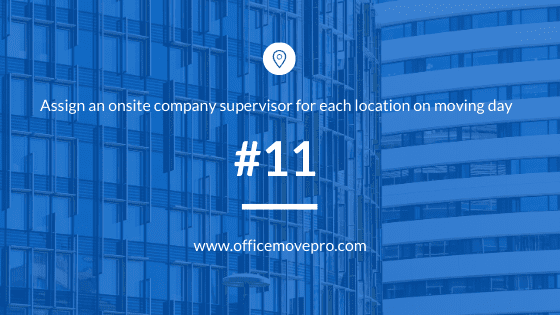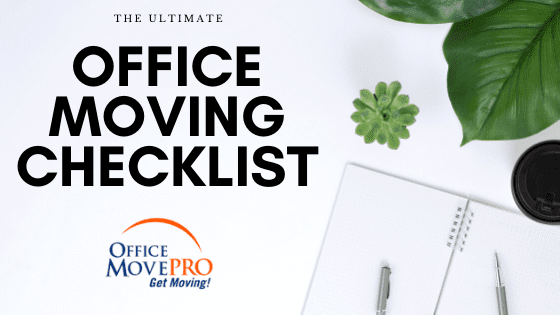Staying organized is the key to a successful office move, because organization saves time. And despite the amount of time it takes to coordinate an office move, we know it’s not the only project you have to manage. While experienced office managers are adept at multitasking, a comprehensive checklist is necessary to keep your move, as well as your team, on track.
We’ve created the ultimate office moving checklist to help you remember every important step – and to have fun along the way. This checklist covers everything you need to do so you can dive right in and get started.
Keep reading for a detailed explanation of each point, or download your printable checklist now.
Download The Ultimate Moving Checklist
1: Create a shared moving folder
This is the very first step you need to take to get, and stay, organized. Quotes, spreadsheets and other documents will accumulate quickly. If you don’t have a place to file them, you could end up doing double the work. Keeping your documents accessible in one convenient location will allow you to streamline communication and easily update your progress.
Use folders and subfolders to store:
- checklists
- spreadsheets
- contacts
- timelines
- budget details
2: Notify your employees
We recommend involving your employees in the relocation process from the start. Avoid notifying your staff by email. Email is better suited to less formal communication. Instead, hold a face-to-face meeting where you can discuss the upcoming relocation and provide your staff with personally addressed letters documenting the news. For sample letters and templates, read this.
3: Assess your office inventory
Take stock of all of your office contents including furniture, equipment, and furnishings. Then determine an appropriate plan for each based on their usefulness and how suitable they are for your new space. Decide what you’ll move, sell, donate or store. Knowing this ahead of time means you can obtain a more accurate quote.
4: Conduct facility walk-throughs with potential movers
Current office
A walk-through your current office will allow movers to estimate firsthand the number of trucks, supplies and movers needed for the job. They can also advise you on appropriate arrangements for specialty items like artwork, oversized and extra heavy items to give you the most accurate quote.
New office
A walk-through your new office with a floor plan will give your movers the best understanding of what’s expected of them on moving day – again allowing them to provide you with an accurate quote.
5: Hire a moving company
Before deciding which moving company to hire, you’ll want to get at least three estimates – including references.
Insider tip: ask for references or case studies that highlight moving projects similar to yours.
Here are a few more things to look for when finding the right business movers:
- reputation: how long has the company been in business and what is their reputation – go beyond the reviews they provide on their website to read firsthand reviewers on Google and other review sites
- responsiveness: are they fast and professional in responding to your initial request? If not, it’s time to move on.
- comprehensive estimates: quotes should include the number of trucks, movers, boxes, and a timeframe for your move
- movers insurance
- professional memberships including BBB, CAM
6: Notify your landlord/property manager of your upcoming move
7: Notify clients & business partners
When it comes to communicating a change of address for your business, clarity and timing are critical. We recommend sending your relocation notice to clients a minimum of 3 weeks before your expected move-in date. More tips for issuing a business relocation notice are available here.
8: Plan office moving activities & events
Beyond the necessities of packing and moving day procedures, think about how you can make moving fun for people. Ideas include a farewell lunch, a week of welcome activities, and a party to celebrate the new space. You may even want to host a special event for clients or business partners in your new space.
9: Confirm details with your movers a few days before moving day
At Office Move Pro, our proprietary Move Net system allows you to view details and track the status of your move by logging in with your unique credentials. We also assign a coordinator to every move so you can have direct, one-to-one contact to address any questions or last minute requests.
10: Book elevators and procure parking permits

12: Review safety procedures with staff
Review company procedures for health and safety as it relates to moving. Answer questions and set safety expectations. You may want to provide a demonstration on how to properly lift and move objects. This is especially helpful for people whose jobs don’t normally involve such physical tasks. Ensure the proper tools—like stepladders, gloves with grips, safety glasses and hard hats—are available as necessary. To prevent tripping hazards, designate specific areas for garbage, donations, and ready-to-move items so boxes and bags aren’t strewn along hallways or blocking doorways.
13: Pack
Instruct your staff on how to pack and label their office and desk contents. Professional office movers can provide you with a variety of tools and tutorials so you can pack your office efficiently and effectively. Don’t forget to empty the fridge!
14: Decommission your office
When you vacate a leased or rented office space, you are responsible for returning it to its original condition in accordance with your lease agreement or rental contract. Otherwise, your property management company may charge additional fees. This may include professional cleaning and minor repairs in addition to removing all of your equipment and furniture.
15: Disconnect utilities & technical equipment
Disconnect technical equipment and label cables as you go. Your office movers can provide further instruction on how to properly disconnect and transport your tech.
16: Cancel or transfer services
Cancel or transfer any independent cleaning services, deliveries or subscriptions.
17: Collect & cancel all employee passes/keys/building access

19: Schedule set up for your new office
Schedule set up for your new office including office furniture assembly and technical equipment installation.
20: Update your business address and contact details
This includes updating your website, online profiles, business cards, and stationery as well as contacting service providers and business partners.
Some moves are easier than others. But remember, you are the one in charge of making sure it all goes well. Our best advice is to use this checklist to stay on track, and hire the best moving support you can find.
Call us today for a free estimate!




